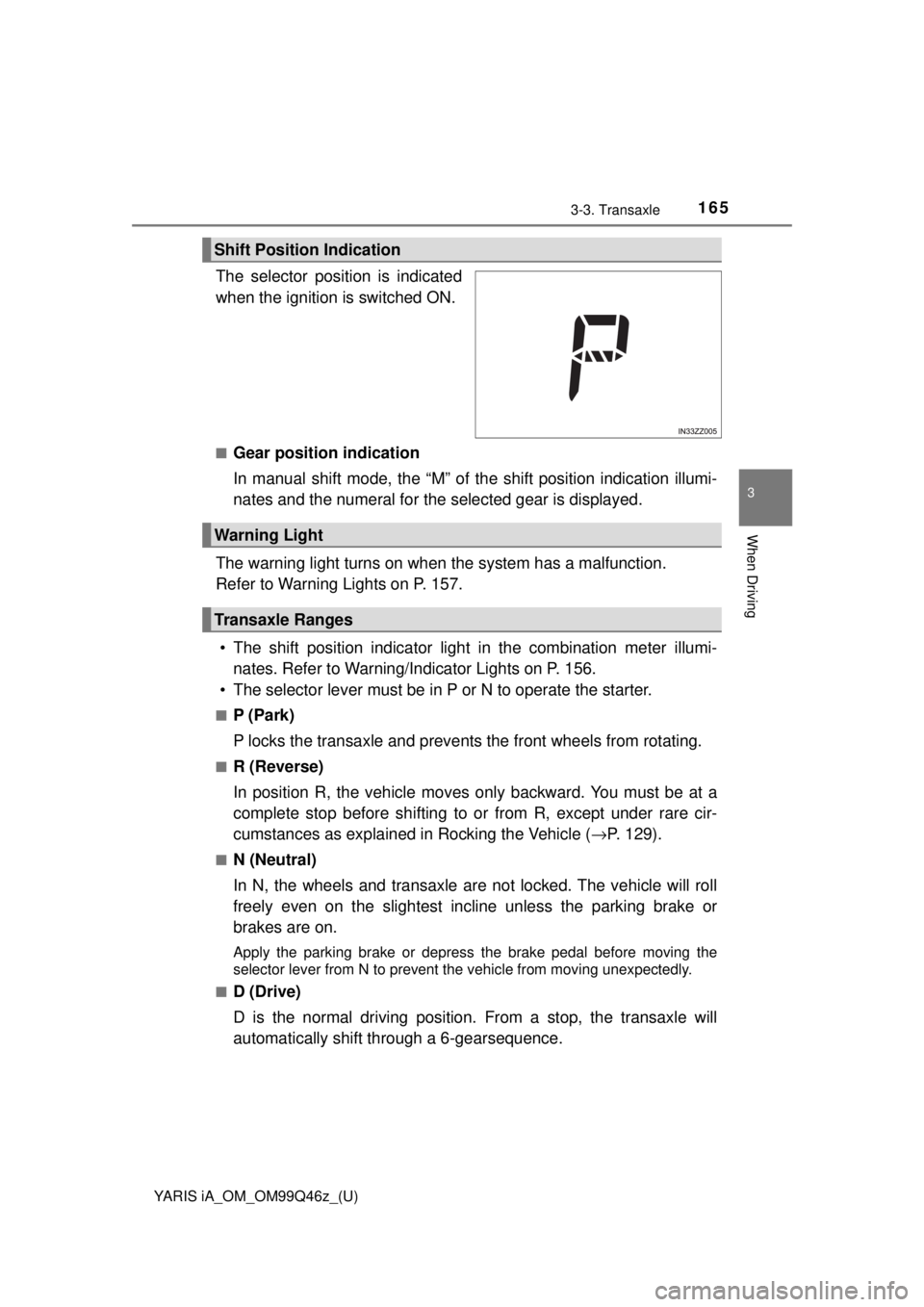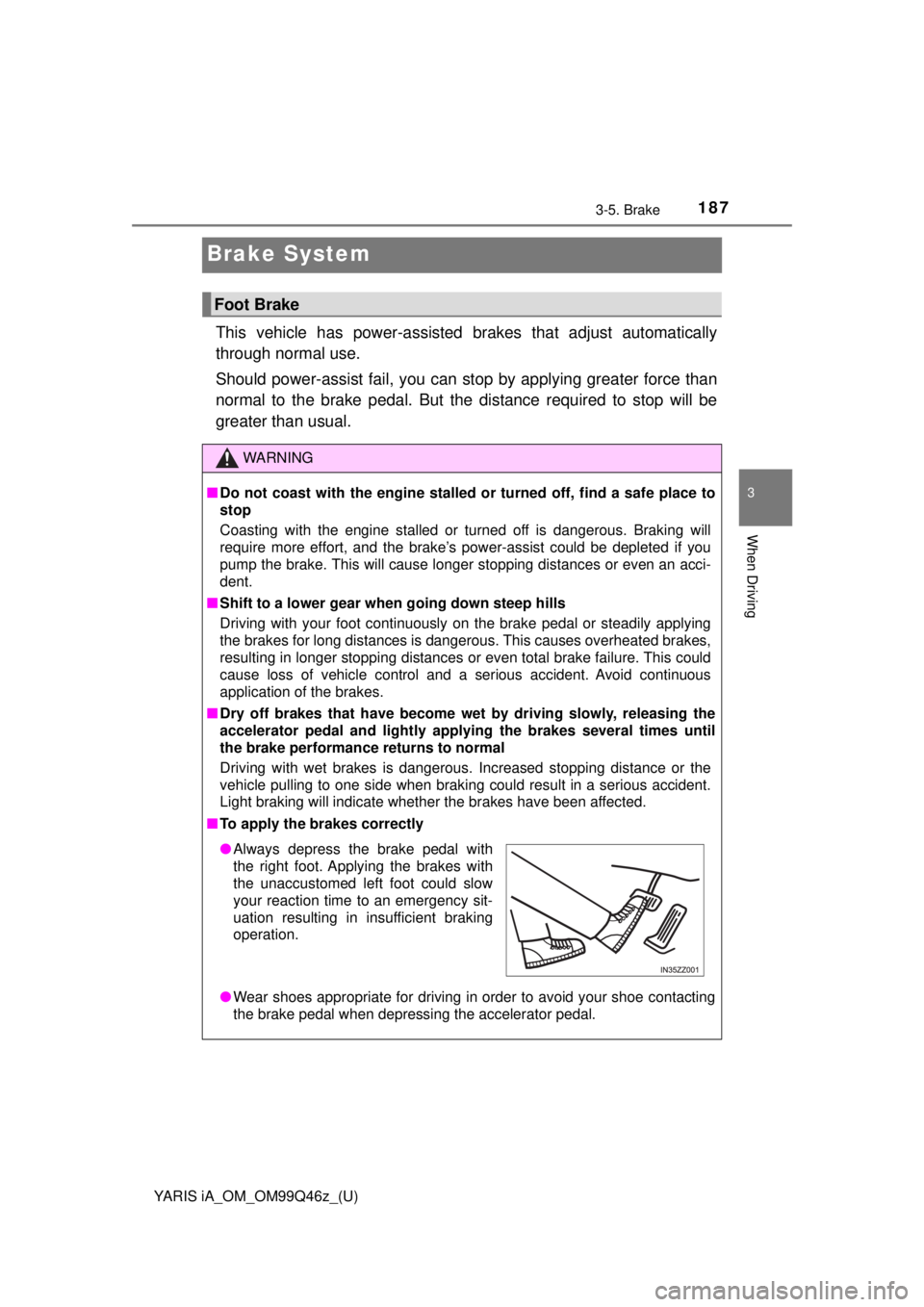Page 126 of 576

126
YARIS iA_OM_OM99Q46z_(U)
2-8. Driving Tips
Saving Fuel and Protection of the Environment
How you operate your Toyota determines how far it will travel on a
tank of fuel. Use these suggestions to help save fuel and reduce CO2.
• Avoid long warm-ups. Once the en gine runs smoothly, begin driv-
ing.
• Avoid fast starts.
• Drive at lower speeds.
• Anticipate when to apply the brakes (avoid sudden braking).
• Follow the maintenance schedule and have your Toyota dealer per- form inspections and servicing.
• Use the air conditioner only when necessary.
• Slow down on rough roads.
• Keep the tires properly inflated.
• Do not carry unnecessary weight.
• Do not rest your foot on the brake pedal while driving.
• Keep the wheels in correct alignment.
• Keep windows closed at high speeds.
• Slow down when driving in crosswinds and headwinds.
WARNING
■ Never stop the engine when going down a hill
Stopping the engine when going down a hill is dangerous. This causes the
loss of power steering and power brake control, and may cause damage to
the drivetrain. Any loss of steering or braking control could cause an acci-
dent.
Page 127 of 576
127
YARIS iA_OM_OM99Q46z_(U)
2-8. Driving Tips
2
Before Driving
Hazardous Driving
When driving on ice or in water, snow, mud, sand, or similar hazards:• Be cautious and allow ex tra distance for braking.
• Avoid sudden braking and sudden maneuvering.
• Do not pump the brakes. Continue to press down on the brake pedal. Refer to Antilock Brake System (ABS) on P. 193.
• If you get stuck, select a lower g ear and accelerate slowly. Do not
spin the front wheels.
• For more traction in starting on slippery surfaces such as ice or packed snow, use sand, rock salt, chains, carpeting, or other non-
slip material under the front wheels.
Use snow chains only on the front wheels.
WARNING
■ Be extremely careful if it is necessary to downshift on slippery sur-
faces
Downshifting into lower gear while driving on slippery surfaces is danger-
ous. The sudden change in tire speed could cause the tires to skid. This
could lead to loss of vehicle control and an accident.
Page 130 of 576

130
YARIS iA_OM_OM99Q46z_(U)
2-8. Driving Tips
Winter Driving
Carry emergency gear, including tire chains, window scraper, flares, a
small shovel, jumper cables, a nd a small bag of sand or salt.
Ask your Toyota dealer to check the following: • Have the proper ratio of antifreeze in the radiator. Refer to Engine Coolant on P. 425.
• Inspect the battery and its cables . Cold reduces battery capacity.
• Use an engine oil appropriate for the lowest ambient temperatures that the vehicle will be driven in ( →P. 422).
• Inspect the ignition sy stem for damage and loose connections.
• Use washer fluid made with antifreeze ⎯but do not use engine cool-
ant antifreeze for washer fluid ( →P. 429).
●Do not use the parking brake in freezing weather as it may freeze. Instead,
shift to 1 or R with a manual transaxle and to P with an automatic transaxle.
Block the rear wheels.
● Remove snow before driving. Snow left on the windshield is dangerous as it
could obstruct vision.
● Do not apply excessive force to a window scraper when removing ice or fro-
zen snow on the mirror glass and windshield.
● Never use warm or hot water for removing snow or ice from windows and
mirrors as it could result in the glass cracking.
● Drive slowly. Braking performance can be adversely affected if snow or ice
adheres to the brake components. If this situation occurs, drive the vehicle
slowly, releasing the accelerator pedal and lightly applying the brakes sev-
eral times until the brake performance returns to normal.
Page 133 of 576
133
YARIS iA_OM_OM99Q46z_(U)
2-8. Driving Tips
2
Before Driving
Driving In Flooded Area
WARNING
■Dry off brakes that have become wet by driving slowly, releasing the
accelerator pedal and lightly applyi ng the brakes several times until
the brake performance returns to normal
Driving with wet brakes is dangerous. Increased stopping distance or the
vehicle pulling to one side when braking could result in a serious accident.
Light braking will indicate whether the brakes have been affected.
NOTICE
Do not drive the vehicle on flooded roads as it could cause short circuiting
of electrical/electronic parts, or engine damage or stalling from water
absorption. If the vehicle has been immersed in water, consult your Toyota
dealer.
Page 165 of 576

YARIS iA_OM_OM99Q46z_(U)
1653-3. Transaxle
3
When Driving
The selector position is indicated
when the ignition is switched ON.
■Gear position indication
In manual shift mode, the “M” of the shift position indication illumi-
nates and the numeral for the selected gear is displayed.
The warning light turns on when the system has a malfunction.
Refer to Warning Lights on P. 157.
• The shift position indicator light in the combination meter illumi- nates. Refer to Warning/Indicator Lights on P. 156.
• The selector lever must be in P or N to operate the starter.
■P (Park)
P locks the transaxle and prevents the front wheels from rotating.
■R (Reverse)
In position R, the vehicle moves only backward. You must be at a
complete stop before shifting to or from R, except under rare cir-
cumstances as explained in Rocking the Vehicle ( →P. 129).
■N (Neutral)
In N, the wheels and transaxle are not locked. The vehicle will roll
freely even on the slightest in cline unless the parking brake or
brakes are on.
Apply the parking brake or depress the brake pedal before moving the
selector lever from N to prevent the vehicle from moving unexpectedly.
■
D (Drive)
D is the normal driving position. From a stop, the transaxle will
automatically shift through a 6-gearsequence.
Shift Position Indication
Warning Light
Transaxle Ranges
Page 174 of 576

174
YARIS iA_OM_OM99Q46z_(U)
3-3. Transaxle
■Passing
For extra power when passing another vehicle or climbing steep
grades, depress the accelerator fully. The transaxle will shift to a
lower gear, depending on vehicle speed.
Some models:
The accelerator pedal may initially feel heavy as it is being depressed,
then feel lighter as it is depressed further. This change in pedal force
aids the engine control system in determining how much the accelerator
pedal has been depressed for performing kickdown, and functions to
control whether or not kickdown should be performed.
■
Climbing steep grades from a stop
To climb a steep grade from a stopped position:
Depress the brake pedal.
Shift to D or M1, depending on the load weight and grade steep-
ness.
Release the brake pedal while gradually accelerating.
■Descending steep grades
When descending a steep grade, shift to lower gears, depending on
load weight and grade steepness. Descend slowly, using the
brakes only occasionally to pr event them from overheating.
Driving Tips
WARNING
■Do not let the vehicle move in a di rection opposite to the direction
selected by the selector lever
Do not let the vehicle move backward with the selector lever in a forward
position, or do not let the vehicle move forward with the selector lever in the
reverse position. Otherwise, the engine may stop, causing the loss of the
power brake and power steering functions , and make it difficult to control
the vehicle which could result in an accident.
1
2
3
Page 187 of 576

187
YARIS iA_OM_OM99Q46z_(U)
3-5. Brake
3
When Driving
Brake System
This vehicle has power-assisted brakes that adjust automatically
through normal use.
Should power-assist fail, you can st op by applying greater force than
normal to the brake pedal. But the distance required to stop will be
greater than usual.
Foot Brake
WARNING
■ Do not coast with the engine stalled or turned off, find a safe place to
stop
Coasting with the engine stalled or turned off is dangerous. Braking will
require more effort, and the brake’s power-assist could be depleted if you
pump the brake. This will cause longer stopping distances or even an acci-
dent.
■ Shift to a lower gear wh en going down steep hills
Driving with your foot continuously on the brake pedal or steadily applying
the brakes for long distances is dangerous. This causes overheated brakes,
resulting in longer stopping distances or even total brake failure. This could
cause loss of vehicle control and a serious accident. Avoid continuous
application of the brakes.
■ Dry off brakes that have become wet by driving slowly, releasing the
accelerator pedal and lightly applyi ng the brakes several times until
the brake performance returns to normal
Driving with wet brakes is dangerous. Increased stopping distance or the
vehicle pulling to one side when braking could result in a serious accident.
Light braking will indicate whether the brakes have been affected.
■ To apply the brakes correctly
● Wear shoes appropriate for driving in order to avoid your shoe contacting
the brake pedal when depressing the accelerator pedal.
●Always depress the brake pedal with
the right foot. Applying the brakes with
the unaccustomed left foot could slow
your reaction time to an emergency sit-
uation resulting in insufficient braking
operation.
Page 188 of 576
188
YARIS iA_OM_OM99Q46z_(U)
3-5. Brake
■Setting the parking brake
Depress the brake pedal and
then firmly pull the parking
brake lever fully upwards with
sufficient force to hold the vehi-
cle in a stationary position.
■Releasing the parking brake
Depress the brake pedal and
pull the parking brake lever
upwards, then press the
release button. While holding
the button, lower the parking
brake lever all the way down to
the released position.
NOTICE
Do not drive with your foot held on the clutch pedal or brake pedal, or hold
the clutch pedal depressed halfway unnecessarily. Doing so could result in
the following:
● The clutch and brake parts will wear out more quickly.
● The brakes can overheat and adversely affect brake performance.
Parking Brake